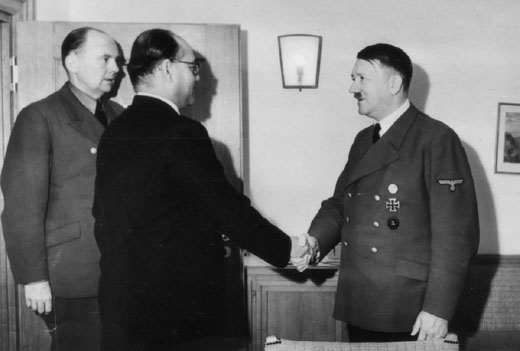Air Operations, CBI
4 7th Heavy Bomb Group B-17s attack the airfield at Myitkyina from high altitude.
[Air Operations, Europe
BOMBER COMMAND- 77 aircraft including 31 Wellingtons, 20 Halifaxes, 14 Lancasters, 9 Stirlings and 3 Hampdens are sent to hit the Gnome and Rhone factory near Paris. Later photographic evidence shows little or no damage to the factory. Reports from the ground say 38 houses are destroyed and 49 damaged. 34 French citizens are killed and 167 are injured. 4 Wellingtons and 1 Halifax are lost on the raid.
- In minor operations, 31 aircraft are sent to bomb Cherbourg and 17 to Dieppe. 21 aircraft lay mines in the Frisians and off Copenhagen and 3 make leaflet flights over France.
Air Operations, New Guinea
8th Fighter Group P-39s down 5 A6M Zeros 50 miles southeast of Port Moresby at 0950 hours.
[Air Operations, Pacific
The Royal Australian Air Force opens bombing operations against Tulagi in the Solomons.
[Australia, Technology
Australia's first home-produced wartime aircraft, the Commonwealth CA-12 Boomerang, makes its first flight. Although designed in only five months, the Boomerang proves to be a tough and maneuverable fighter.
Diplomatic Relations
Soviet Foreign Minister Molotov arrives in Washington to discuss US arms aid to Russia and review US-British planning for a second European front in 1942. He will be there until June 4.
Molotov, Soviet foreign minister, is at the White House. President Roosevelt promises him that the Western Allies will open a second front in 1942. Molotov rejects a suggestion by Roosevel that the USSR agrees a treaty with Germany on the prisoners of war issue. Soviet troops in German hands do not have any international protection as the USSR has not signed the Geneva Convention of 1929, which specifies humane treatment for prisoners of war. This official posture stems from the Soviet concept of battlefield bahavior. The Red Army field manual states that a loyal soldier is either fighting or is dead; surrender is considered to be treason. The wartime edition of the standard Soviet encyclopedia states that 'the penalty for premeditated surrender into captivity not necessitated by combat conditions is death by shooting'.
[Eastern Front
The Germans complete their encircling maneuver west of the Donets. The Russians have lost 250,000 men. They have badly underestimated the German strength and preparedness. In fact the Germans had intended in any event to pinch out the Russian salient and the Russian attacks between May 12 and 19 only made this operation more worthwhile.
SOUTHERN SECTORThe Izyum battle is largely over as the Soviet surrender. Barely 22,000 men have escaped. The battle since the 12th has cost the Soviets 170,958 killed or captures and 106,232 wounded, 1,250 tanks and 2,000 artillery pieces destroyed or captured. Gens Kostenko, Podlas, Bobkin and Gorodnyanski all fall in the fighting.
The disastrous offensive leaves the Southwest Front with barely two thirds of its original strength, while the German 6th Army has suffered only 20,000 casualties during the operation.
The debacle at Kharkov proved once again the inability of the Soviet Command to master a rapidly developing situation. Sticking rigidly to pre-determined goals in spite of a significant change in combat conditions had cost the Red Army a quarter of a million men. Stalin's refusal to heed the advice of his generals had had the same results as in the summer of '41. However, the defeat at Kharkov had been an outstanding achievement for the Germans. A seemingly desperate situation had been turned to their advantage, and a considerable force, which would have presented real problems had it been intact at the time of the impending offensive, had been disposed of relatively easily. This victory went a long way toward rebuilding German confidence, so badly shaken during the winter.[
Subhash Chandra Bose and Adolf Hitler |
 |
Madagascar
A Japanese midget submarine enters Diego Suarez harbor and heavily damages the British battleship Ramillies and sinks a tanker with its torpedoes.
[North Africa
There is heavy fighting around the 'Knightsbridge' road junction, but the British fail to develop a coordinated attack and the German antitank guns are as usual most effective. The Italian Trieste Div which had blundered into 150th Bde on the 26th has now managed to clear a path through their position. This path is to be a lifeline for the Afrikakorps. Most of Rommel's tanks, temporarily on the defensive because they cannot open up a supply line, withdraw southwards under the pressure from the tanks of XXX Corps.[MORE]
[Pacific
The US submarine Swordfish (SS-193) sinks the Japanese cargo ship Tatsufuku Maru (1945t) at the southwestern entrance to Balabac Strait.
[United States, Home Front
Actor John Barrymore dies at age 60.
[